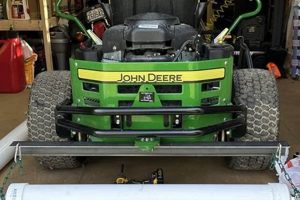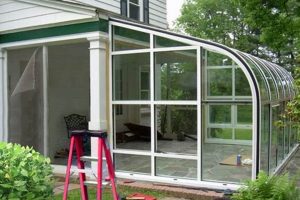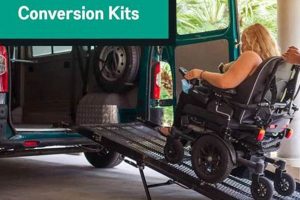Pre-packaged collections of guitar components designed for assembly by the end user at a lower cost than pre-built instruments represent an accessible entry point into guitar building and modification. These sets typically include a body, neck, hardware, and electronics, requiring the assembler to complete tasks such as finishing, wiring, and setup. A common example is a kit containing a Stratocaster-style body, maple neck, pickups, and all necessary screws and knobs.
The appeal of these build-it-yourself options lies in their potential for cost savings, educational value, and customization possibilities. They provide a practical understanding of guitar construction and electronics while allowing for personalized aesthetic and functional adjustments. Historically, these kits emerged as a way to make guitar ownership more affordable and to cater to hobbyists and individuals seeking a deeper connection with their instruments.
The subsequent sections will delve into the types of available sets, essential tools and techniques required for successful assembly, and potential modifications to enhance the final product. Furthermore, a discussion of common pitfalls and troubleshooting strategies will be presented, followed by guidance on selecting the appropriate option based on skill level and budget.
Assembly Guidance
The successful construction of instrument from component collections necessitates careful planning and meticulous execution. The following guidelines serve to enhance the build process and mitigate potential complications.
Tip 1: Inventory Verification: Upon receipt, meticulously check all components against the provided parts list. Discrepancies should be addressed with the supplier before commencing the build.
Tip 2: Surface Preparation: Prior to finishing, ensure the wood surfaces are smooth and free from imperfections. Sanding with progressively finer grits of sandpaper is recommended.
Tip 3: Neck Alignment: Precise neck alignment is crucial for playability. Verify the neck sits squarely in the pocket before securing it permanently. Utilize shims if necessary to achieve proper alignment and action.
Tip 4: Electrical Grounding: Implement a robust grounding scheme to minimize unwanted noise. Ensure all electronic components are properly grounded to a common ground point, such as the potentiometer casing or bridge.
Tip 5: Shielding Cavities: Applying shielding paint or copper foil to the control and pickup cavities can further reduce interference. Overlap the shielding material to create a Faraday cage effect.
Tip 6: String Alignment: After assembly, confirm that the strings align correctly over the fretboard and pickup pole pieces. Adjust the bridge and nut as needed to achieve optimal string spacing.
Tip 7: Intonation Adjustment: Accurate intonation is paramount for consistent pitch across the fretboard. Adjust the bridge saddles at the 12th fret until the fretted note matches the harmonic.
By adhering to these recommendations, builders can significantly improve the likelihood of creating a playable and sonically satisfying instrument. Attention to detail and patience are key to a successful outcome.
The concluding section will offer a summarization of the project’s key stages and highlight the long-term advantages of partaking in this assembly process.
1. Affordability
The affordability factor is central to the appeal and accessibility of economy self-assembly guitar sets. The lower initial cost allows individuals with limited budgets to engage in guitar building, a pursuit that might otherwise be financially prohibitive. This reduced expense is achieved primarily through economies of scale in component manufacturing and by shifting the labor of assembly from the manufacturer to the consumer. For example, a completed guitar from a major brand might retail for several hundred dollars, whereas a comparable unassembled option can often be obtained for a fraction of that cost.
The reduced financial commitment significantly broadens the market for guitar building and modification. Students, hobbyists, and individuals seeking an entry point into luthiery are drawn to these kits. However, the affordability is not without potential implications. The use of less expensive materials, such as lower-grade woods, budget-oriented hardware, and import-branded electronics, is common. While functional, these components may exhibit reduced longevity, tonal characteristics, or overall build quality compared to higher-priced alternatives. Therefore, a balance must be struck between cost savings and desired performance attributes.
In conclusion, the price point is paramount for the popularity of instrument-building sets. While potential trade-offs exist in component quality, the lower financial barrier to entry makes guitar building accessible to a wider demographic, fostering creativity and providing a valuable learning experience. Users should, therefore, carefully weigh their budget constraints against their desired performance criteria to ensure a satisfactory outcome.
2. Customization
The intrinsic link between instrument-building sets and personalization represents a core driver for their popularity. These kits provide a platform for users to create an instrument uniquely tailored to their preferences, extending far beyond what is typically achievable with off-the-shelf guitars. This customization manifests across several key areas: aesthetic finishes, hardware selection, and electronic configuration. The ability to apply a specific paint color, stain, or wood finish, for instance, enables the creation of an instrument visually distinct from mass-produced models. Moreover, selecting different pickups, bridges, tuning machines, and control knobs allows for functional and stylistic modifications to match individual playing styles and tonal requirements. A user might, for example, opt for high-output humbucker pickups for a heavier sound, or vintage-style single-coil pickups for a brighter, more articulate tone.
The accessibility of these modifications is significantly enhanced by the relatively low cost of instrument assembly collections. Modifying a completed, expensive guitar often carries a higher risk due to the potential for damaging the original instrument or diminishing its resale value. With an assembled-it-yourself set, the lower initial investment makes experimentation less daunting. The user is free to try different wiring schemes, pickup combinations, or even body modifications without the fear of compromising a valuable instrument. This facilitates a learning process where the user can gain a deeper understanding of how each component contributes to the overall sound and playability of the guitar. For example, a user might experiment with different capacitor values in the tone circuit to explore their impact on the tonal response of the instrument, or rout the b
ody to accommodate a different pickup configuration.
Ultimately, the opportunity for personalization afforded by instrument-construction sets empowers users to create instruments that are both functional and aesthetically aligned with their individual preferences. While some compromise in material quality may be necessary to maintain affordability, the freedom to customize every aspect of the instrument remains a compelling advantage. This blending of creative expression and practical instrument building positions these kits as a valuable tool for both novice and experienced guitar enthusiasts.
3. Education
The construction of instruments from component form provides a valuable educational experience in applied physics, woodworking, and electronics. The process necessitates understanding the function of each part and its contribution to the overall performance of the instrument. For example, correctly wiring potentiometers requires knowledge of basic circuit principles. Similarly, achieving proper intonation demands an understanding of scale length and string tension. The hands-on nature of this process solidifies theoretical knowledge in a practical context. A user building an instrument, for example, learns through direct experience the impact of different wood densities on the instrument’s tone, or the influence of pickup placement on the frequency response.
The process of building a instrument from parts offers an accessible entry point into the fields of luthiery and musical instrument repair. The skills acquired through this activity are directly transferable to more advanced projects, such as custom guitar building or instrument modification. A person who learns to properly level and crown frets on one of these kits, for instance, can apply those same techniques to repair or improve existing instruments. Furthermore, troubleshooting problems that arise during the assembly process develops critical thinking and problem-solving abilities, essential skills in any technical field. For instance, diagnosing and resolving buzzing issues often requires a systematic approach to identifying and eliminating sources of vibration or electrical interference.
In summary, the educational benefits associated with building instruments are multifaceted, encompassing practical skills, theoretical knowledge, and problem-solving abilities. This educational component, although not always the primary motivation, significantly enhances the value proposition of instrument kits, providing a learning experience that extends far beyond the mere acquisition of a musical instrument. Challenges, such as the need for specialized tools and technical knowledge, exist but can be overcome with readily available resources and online communities dedicated to instrument building.
4. Component Quality
The selection of materials and parts directly influences the final performance and longevity of any assembled instrument, particularly within the realm of cost-effective self-assembly sets. Compromises in component quality are often a necessary trade-off to achieve a lower price point; however, understanding the implications of these compromises is crucial for informed decision-making.
- Wood Selection
The type and quality of wood used for the body and neck significantly impact tone, sustain, and overall stability. Lower-priced sets may utilize less resonant or multi-piece wood, potentially affecting the instrument’s acoustic properties and long-term structural integrity. For instance, a body constructed from basswood might lack the tonal richness of a mahogany or alder body.
- Hardware Durability
Tuning machines, bridges, and other hardware components are subjected to considerable stress during playing. Inexpensive hardware may be prone to premature wear, corrosion, or failure, leading to tuning instability and compromised playability. As an example, tuning machines with low gear ratios or poorly machined gears might exhibit slippage or difficulty in achieving precise tuning.
- Electronics Performance
Pickups, potentiometers, and capacitors are fundamental to the instrument’s amplified sound. Budget-oriented electronics may exhibit higher noise levels, limited frequency response, and reduced dynamic range. A pickup with weak magnets, for example, would produce a thin, uninspiring tone, while low-quality potentiometers might develop scratchiness or inconsistent resistance over time.
- Fret Material and Craftsmanship
The quality of frets directly impacts playability and intonation. Inexpensive frets may be made from soft alloys that wear down quickly, leading to fret buzz and intonation problems. Poor fretwork, such as uneven fret heights or sharp fret ends, can also negatively affect the playing experience. For example, improperly installed frets can cause notes to choke out or sound out of tune, particularly in the higher registers of the neck.
Recognizing the potential limitations imposed by budget-conscious components allows builders to make informed choices regarding upgrades or modifications. While it is possible to significantly enhance the performance of a budget set by replacing key components, the overall value proposition should be carefully considered. An instrument built from inexpensive parts might serve as an excellent learning platform or a starting point for customization; however, understanding its inherent limitations is critical for setting realistic expectations.
5. Assembly Skill
Proficiency in assembly plays a decisive role in the successful completion and ultimate playability of instruments originating from build-it-yourself collections. The final quality of such instruments is heavily influenced by the builder’s technical aptitude and attention to detail, especially when dealing with potentially less forgiving, budget-conscious components frequently included in value-oriented kits.
- Soldering Proficiency
Reliable electrical connections are crucial for proper signal flow and instrument functionality. Poor soldering techniques can lead to intermittent signal loss, unwanted noise, or complete circuit failure. A cold solder joint, characterized by insufficient heat and inadequate solder flow, is a common issue resulting from inadequate soldering skills.
- Woodworking Precision
Proper neck alignment, fret leveling, and bridge installation require basic woodworking skills and precise measurements. Misaligned components can significantly compromise playability, intonation accuracy, and overall instrument stability. For example, an improperly seated neck can lead to high action, making the instrument difficult to play.
- Finishing Techniques
Achieving a smooth, durable finish demands proper surface preparation, application techniques, and curing procedures. An uneven or poorly applied finish can detract from the instrument’s aesthetic appeal and potentially affect its acoustic properties. For instance, excessive build-up of finish in the neck pocket can alter the instrument’s tone and sustain.
- Setup Expertise
Precise adjustment of string height, intonation, and tru
ss rod relief is essential for optimal playability and accurate tuning across the fretboard. Inadequate setup skills can result in buzzing frets, inaccurate intonation, and an instrument that is generally difficult to play comfortably. Examples include buzzing caused by overly low action or an improperly adjusted truss rod.
Therefore, the selection of an appropriate instrument assembly set should be directly aligned with the builder’s existing skill level. Novices may benefit from starting with simpler kits that require minimal modifications, while more experienced builders can tackle more complex projects involving extensive customization. Regardless of skill level, meticulous attention to detail and a willingness to learn are essential for achieving a satisfactory outcome with these budget-conscious instruments.
6. Finishing Options
The application of a protective and aesthetically pleasing finish is a critical step in the completion of instruments constructed from self-assembly guitar sets. Within the landscape of budget-conscious kits, the finishing stage presents both opportunities for personalization and potential challenges related to cost and material limitations.
- Paint Application Methods
Spray painting, whether utilizing aerosol cans or professional spray equipment, represents a common method for applying opaque finishes. The evenness of application and the prevention of imperfections, such as runs or orange peel texture, necessitate proper technique and surface preparation. Budget kits may not include detailed instructions or recommendations for specific paint types, requiring the assembler to acquire this knowledge independently. For example, some paints may react adversely with certain wood types or require specific primers for optimal adhesion.
- Staining and Sealing
Staining enhances the natural grain of the wood, while sealing provides a protective barrier against moisture and environmental factors. The selection of appropriate stains and sealers is crucial for achieving the desired aesthetic outcome and ensuring long-term durability. Inexpensive kits might lack clear guidance on compatible stain and sealer combinations, potentially leading to undesirable color interactions or adhesion problems. For example, using an oil-based stain followed by a water-based sealer can result in an uneven or blotchy finish.
- Clear Coat Application
Clear coats provide a glossy or matte protective layer over the painted or stained surface, enhancing its durability and aesthetic appeal. Different types of clear coats, such as lacquer, polyurethane, and varnish, offer varying levels of hardness, chemical resistance, and ease of application. Budget kits might not specify the type of clear coat best suited for the included wood or finish, leaving the assembler to experiment with different options. For instance, applying a thick layer of polyurethane over a soft wood can create a finish that is prone to chipping or cracking.
- Surface Preparation and Sanding
Proper surface preparation, including sanding and filling any imperfections, is essential for achieving a flawless finish. Budget kits may require more extensive sanding to remove blemishes or unevenness in the wood. The selection of appropriate sandpaper grits and sanding techniques is crucial for preventing scratches or swirl marks that can compromise the final finish. Failure to properly prepare the surface can result in a finish that appears uneven or reveals underlying imperfections.
The finishing stage of instrument construction from low-cost assembly collections provides a significant opportunity for customization and creative expression. However, achieving professional-quality results necessitates careful planning, meticulous execution, and a thorough understanding of the materials and techniques involved. Assemblers should be prepared to invest time and resources into acquiring the necessary knowledge and skills to overcome the potential challenges associated with budget-oriented kits.
7. Hardware Upgrade
The replacement of original components with higher-quality alternatives represents a common practice among individuals utilizing budget-conscious self-assembly instrument collections. This endeavor seeks to improve the instrument’s performance, reliability, and aesthetic appeal, often addressing perceived shortcomings in the kit’s original hardware.
- Tuning Machine Enhancement
The substitution of stock tuning machines with models exhibiting higher gear ratios, improved construction, and enhanced stability directly impacts tuning accuracy and ease of use. Economical instrument sets often include tuning machines with lower precision, making accurate tuning difficult and increasing the frequency of adjustments. Aftermarket options with sealed mechanisms and higher gear ratios provide greater stability and smoother operation.
- Bridge and Tremolo System Modification
Upgrading the bridge or tremolo system can significantly affect sustain, intonation, and overall playability. Budget-oriented sets frequently incorporate bridges made from less durable materials or exhibiting design limitations. Replacing these with higher-quality alternatives, constructed from materials such as steel or brass, can improve sustain and tonal response. Furthermore, upgrading the tremolo system can enhance its smoothness and stability, allowing for more precise vibrato effects.
- Pickup Replacement
The exchange of stock pickups with aftermarket models represents a common path to altering the instrument’s tonal characteristics. Economical sets commonly include pickups designed for affordability rather than optimal sonic performance. Replacing these with higher-quality pickups, tailored to specific musical styles or tonal preferences, can dramatically improve the instrument’s amplified sound. For instance, swapping ceramic pickups with alnico pickups can result in a warmer, more nuanced tone.
- Control Potentiometer and Switch Improvement
The replacement of potentiometers and switches impacts the instrument’s electronic functionality and reliability. Inexpensive potentiometers may exhibit scratchiness, inconsistent response, or premature failure. Upgrading to higher-quality potentiometers, often with smoother tapers and greater durability, can improve the precision and longevity of the control circuits. Similarly, replacing stock switches with more robust alternatives can enhance reliability and prevent signal dropouts.
These hardware modifications, while adding to the overall cost of the project, can substantially improve the functionality and performance of an instrument originating from a cost-effective build-it-yourself collection. However, careful consideration should be given to compatibility and installation requirements to ensure a successful upgrade. The decision to replace specific components should be based on a clear understanding of their individual contributions to the instrument’s overall performance and the user’s specific needs and preferences.
Frequently Asked Questions
The following section addresses common inquiries regarding budget-friendly instrument-building collections. These answers aim to clarify potential misconceptions and provide essential information for individuals considering such proje
cts.
Question 1: Are instruments built from these kits comparable in quality to factory-made guitars?
The final quality is heavily dependent on the assembler’s skill and the quality of components. While the potential exists to create a playable instrument, it is unlikely to match the precision and consistency of a professionally manufactured guitar without significant upgrades.
Question 2: What tools are absolutely necessary for assembling one of these kits?
Essential tools include a soldering iron, wire cutters, screwdrivers (various sizes), a multimeter, a set of files, sandpaper, and a measuring tape. Depending on the desired finish, additional tools for painting or staining may be required.
Question 3: Can the components in these kits be easily upgraded?
Yes, most components are easily replaceable with higher-quality aftermarket parts. Common upgrades include pickups, tuning machines, bridges, and electronic components. However, compatibility should be verified before purchasing replacement parts.
Question 4: What level of experience is required to successfully assemble one of these kits?
A basic understanding of electronics and woodworking is beneficial, but not always essential. Many kits are designed for beginners and include detailed instructions. However, patience and attention to detail are crucial, regardless of experience level.
Question 5: Are these kits suitable for professional musicians?
While the final quality can be improved through careful assembly and component upgrades, they are generally not intended for professional use without significant modifications. These kits are better suited for hobbyists, students, or individuals seeking a project to learn about guitar construction.
Question 6: What are the most common pitfalls to avoid during assembly?
Common mistakes include poor soldering, incorrect wiring, misaligned neck, improper intonation, and inadequate finishing. Careful adherence to instructions and thorough research can help prevent these issues.
These frequently asked questions highlight critical considerations for individuals contemplating the construction of instruments from budget-oriented collections. Awareness of potential limitations and the importance of proper assembly techniques is paramount for a successful outcome.
The subsequent article section will offer a conclusive summary of the topic.
Conclusion
The preceding analysis has explored the multifaceted aspects of cheap diy guitar kits. It is evident that while these sets offer an accessible entry point into instrument building, they present inherent trade-offs concerning component quality and assembly expertise. The potential for customization and education serves as a significant draw, yet necessitates a realistic understanding of the limitations imposed by budget constraints. The successful realization of a playable instrument hinges on meticulous execution and a willingness to address potential challenges.
Therefore, prospective builders should carefully evaluate their skill level, budgetary considerations, and desired outcome before embarking on such a project. The pursuit of constructing an instrument from these materials represents a commitment to both learning and craftsmanship. Ultimately, the value derived from a cheap diy guitar kit extends beyond the instrument itself, encompassing the knowledge and experience gained throughout the assembly process. Continued advancements in component manufacturing and kit design may further enhance the accessibility and quality of these offerings in the future.







